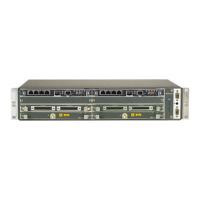User Manual
Product information and planning
9500 MPR Rel. 3.1
3DB18809AAAA Issue 148/980
2.1.3 MSS Purpose, Function and Description
The MSS shelf houses the indoor cards. It is available in two versions:
– MSS-8
– MSS-4
The MSS provides cross-connection, port aggregation, switching, and equipment management.
The MSS shelf consists of card cage and backplane in which mounts access and radio peripheral and
Core-E control plug-in cards (see
Figure 6. and Figure 7.).
Figure 6. MSS-8 shelf
Figure 7. MSS-4 shelf
The Core-E modules provide six Ethernet user interfaces (4 electrical interfaces as default + 2 electrical/
optical interfaces available with optional SFP. Note: for the available SFPs refer to par.
2.8.1.3), the local
WebEML interface and the local debug interface.
The Main Core-E and the Spare Core-E modules have a different role.
The Main Core-E is always provided. It performs key node management and control functions, and
provides various dc rails from the -48 Vdc input. It also incorporates a plug-in flash card, which holds node
configuration and license data.
The Main Core-E also includes the cross-connection matrix, which implements all the cross-connections
between the Transport modules, between the Ethernet user ports and between the Ethernet user ports
and the Transport modules. The matrix is a standard Ethernet switch, based on VLAN, assigned by the
WebEML.
The Ethernet ports of the Core-E can be configured in 2 ways:
1) to be used as GigaEthernet interface for Ethernet traffic (Note: for port#5 and port#6 the
optional SFP must be installed);
2) to be used to connect an MPT: MPT-HC or MPT-MC to port#1 to port#4; an MPT-HC only to
port#5 and port#6.
Transport
module
Transport
module
Transport
module
Transport
module
Transport
module
Transport module
or AUX peripheral
module
Main Core-E
module
Spare Core-E
module
FANS
module
Transport
module
Transport module
or AUX peripheral
module
Main Core-E
module
Spare Core-E
module
FANS
module

